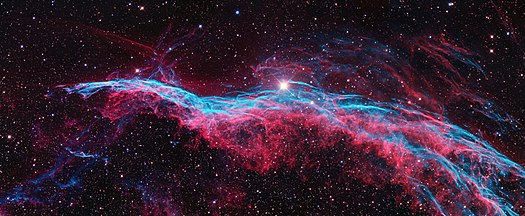Today, with only some help from a low-grade telescope, it is possible to see into the interior of the Veil Nebula to distinguish more than 24 different aspects. In fact, many of its aspects are so easy to visually identify that they have earned their own nicknames as well as their own NGC (New General Catalog) entry numbers.
The nebula has helped many a budding astronomer fall head over heels in love with studying the cosmos. It is so complex and intricate – as well as so enormous – that simply studying its parts could easily occupy any student for many productive and enjoyable years.

Veil Nebula Profile
Designation: NGC 6960 (Western Veil Nebula), NGC 6992 (Eastern Veil Nebula; one-half of Network Nebula with NGC 6995), NGC 6995 (bright arc in south NGC 6992), NGC 6974 (diffuse nebula east of Simeis 3-188), and NGC 6979 (2nd diffuse nebula east of Simeis 3-188); a particular arc in the Eastern Veil Nebula is designated IC 1340; Pickering’s Triangle is designated Simeis 3-188; a bright nebulous patch in Pickering’s Triangle is designated Simeis 3-210.
Type: Supernova remnant (diffuse nebula)
Diameter: 110 light years
Distance: 2,100 light years
Mass: 1.989 × 10^30 kg x 20
Constellation: Cygnus
Facts About the Veil Nebula
- The Veil Nebula first formed about 8,000 years ago when an incredibly massive red giant star at least 20 times the size (mass) of the Sun exploded.
- Because the nebula is so enormous and its brightness often varies depending on the activity of the cosmic dust cloud that surrounds and interacts with it, various components have been discovered and catalogued at various points in history.
- William Herschel, the same astronomer who coined the term “planetary nebulae,” was the first to discover and document the Veil nebula on September 5, 1784. He discovered the western end of the nebula first and later went on to discover, describe and categorize additional elements in the NGC (New General Catalog).
- In 1844, William Parsons, 3rd Earl of Rosse, an Anglo-Irish astronomer, made a sketch of NGC 6974 after seeing it in his telescope.
- In 1866, an American mathematical and calculating genius and future observatory director and astronomer named Truman Henry Safford discovered and catalogued IC 1340.
- Then in 1904, a Scottish astronomer named Williamina Paton Stevens Fleming discovered Pickering’s Triangle, which was named after her boss and observatory director, Edward Charles Pickering.
- The Veil Nebula and its various components has accumulated a vast assortment of nicknames, some of the most famous of which include these: Cygnus Loop, Cirrus Nebula, Filamentary Nebula, Witch’s Broom Nebula, Bridal Veil Nebula, Finger of God, Network Nebula.
Easy Targets
- For beginning astronomers, the bright star 52 Cygni makes the Western Veil portion of the nebula very easy to locate. Even though the star and the supernova remnant are not connected, this is a great way to spot the Veil Nebula and can often be done without even binoculars.
- Because the nebula itself is immense and diverse in its many parts, some aspects are much brighter than others.
- Because the supernova explosion that created the Veil Nebula was so vast and violent, it is sometimes called “The Titanic Explosion.”
- At the very core (center) of the Veil Nebula is a neutron star, or possibly a black hole. It was created when the internal collapse of the massive star sent shock waves emanating out in all directions.
- Astronomers now believe that the original giant star generated such strong cosmic winds that it blew a hole right through the center of the interstellar gases before the explosion even took place. When the star finally exploded, the shock waves generated by the explosion impacted this surrounding gaseous shell, which created the glow observers still see today. In fact, the shock wave is continuing to unfold at an estimated 40 km/second (one million miles per hour).
- Photos taken in 1997 and photos taken in 2015 highlight the ongoing movement within the nebula. By tracking individual knots, or filaments of hydrogen gases, astronomers can in turn track how the Veil Nebula itself is expanding and changing.
Not On The Visible Spectrum
- Certain portions of the Veil Nebula do not give off any visible light, which makes them impossible to detect in normal images. However, when viewed with X-ray, radio or infrared technology, these sections become visible.
- The entire visible region that the Veil Nebula currently occupies in the night sky is equal to six full Moons stacked end to end.
- The nebula gives off both hard X-rays and soft X-rays. Soft X-rays comprise the band of X-radiation that are used in medical technology to create images of very tiny (nano-scale) objects.
- The Veil Nebula is one of the most important X-ray sources in the cosmos, as well as one of the largest and brightest. Chemical analysis reveals hydrogen, helium, oxygen, sulphur gases.
- The different structures inside the nebula system – from smooth and curved to fluffy and diffuse – are created due to different temperatures and different time periods after the original explosion. In general, the smoother structures are thought to have been created more recently than the more diffuse or chaotic structures.
Image sources:
- By Ken Crawford – http://www.imagingdeepsky.com/Nebulae/NGC6960/FullSizeJpg/NGC6960.jpg, CC BY-SA 3.0, https://commons.wikimedia.org/w/index.php?curid=30574320